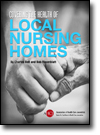The Government Accountability Office has followed up its May 2008 report that found a high level of inconsistency in nursing home evaluations (PDF) with a blockbuster sequel: Addressing the Factors Underlying Understatement of Serious Care Problems Requires Sustained CMS and State Commitment (PDF).
In this report, the GAO seeks to figure out exactly what’s causing state inspectors to miss serious violations on at least 15 percent of their surveys. The answers? Bad survey methodology, workforce shortages, inexperienced surveyors, bad survey documentation, odd state practices and, most interestingly, outside pressure from stakeholders like those in the nursing home industry.
The entire report deserves a close review, but for now we’ll settle for a few cherry-picked highlights. Keep in mind that while the federal government sets and enforces standards, much of the process, including hiring, training and review of surveyors, is left up to the discretion of the states. For the report, the GAO surveyed 98 percent of state agency directors (Pennsylvania’s Deputy Secretary for Quality Assurance asked that state’s surveyors not respond) and 61 percent of eligible nursing home surveyors.
Practices vary, as do the reasons behind them
“Forty percent of surveyors in five states and four directors reported that their state had at least one practice not to cite certain deficiencies.”
“… over 40 percent of surveyors in four states reported that their states’ informal dispute resolution processes favored concerns of nursing home operators over resident welfare.”
“… directors from seven states reported that pressure from the industry or legislators may have compromised the nursing home survey process, and two directors reported that CMS’s support is needed to deal with such pressure.”
“If surveyors perceive that certain deficiencies may not be consistently upheld or enforced, they may choose not to cite them.”
“Fifty-four percent of surveyors nationwide reported on our questionnaire that supervisors at least sometimes removed the deficiency that was cited, and 53 percent of surveyors noted that supervisors at least sometimes changed the scope and severity level of cited deficiencies. Of the surveyors, who reported that supervisors sometimes removed deficiencies, 13 percent reported that supervisors always or frequently removed deficiencies — including 12 states with 20 percent or more of their surveyors reporting that deficiencies were removed.”
The survey – the length and complexity of which was cited as a contributor to incorrect deficiency reporting – includes 200 standards grouped into 15 categories, which are then rated based on a scope and severity grid.
Scale is always an issue
About 1.5 million Americans live in nursing homes. That’s more than live in Maine, Hawaii, South Dakota or any one of eight other states. Combine this with state budget issues, and you can see how scale would be a serious obstacle to consistency.
“More than two-thirds of state agency directors reported on our questionnaire that staffing posed a problem for completing complaint surveys, and more than half reported that staffing posed a problem for completing standard or revisit surveys. In addition, 46 percent of state agency directors reported that time pressures always, frequently, or sometimes contributed to understatement in their states.”
Does CMS new survey system fix anything?
When the GAO sent out its questionnaires, eight states had begun adopting QIS, which is CMS’ new, and theoretically improved, nursing home survey method (PDF). While the sample size is small, early returns aren’t promising:
There was no consensus among the eight state agency directors who had started implementing the QIS as of November 2008 about how the new survey methodology would affect understatement.44 Three directors reported that the QIS was likely to reduce understatement; three directors reported that it was not likely to reduce understatement; and two directors were unsure or had no opinion… Similarly, there was no evidence that the QIS resulted in higher-quality documentation or improved surveyor efficiency.
 Slim guide:
Slim guide:
Covering the Health of Local Nursing Homes
Check out AHCJ’s latest volume in its ongoing Slim Guide series. This reporting guide gives a head start to journalists who want to pursue stories about one of the most vulnerable populations – nursing home residents. It offers advice about Web sites, datasets, research and other resources. After reading this book, journalists can have more confidence in deciphering nursing home inspection reports, interviewing advocacy groups on all sides of an issue, locating key data, and more. The book includes story examples and ideas.
AHCJ publishes these reporting guides, with the support of the Robert Wood Johnson Foundation, to help journalists understand and accurately report on specific subjects.
Other resources





